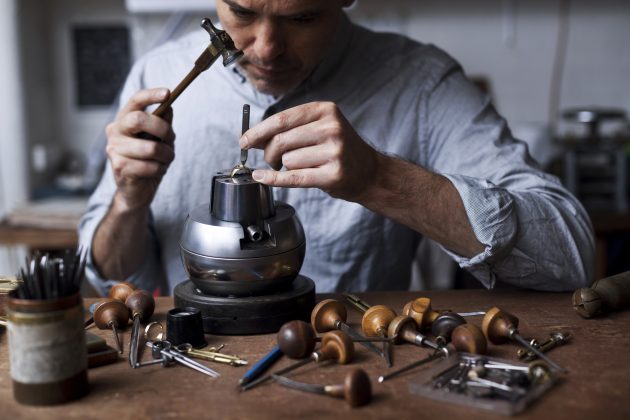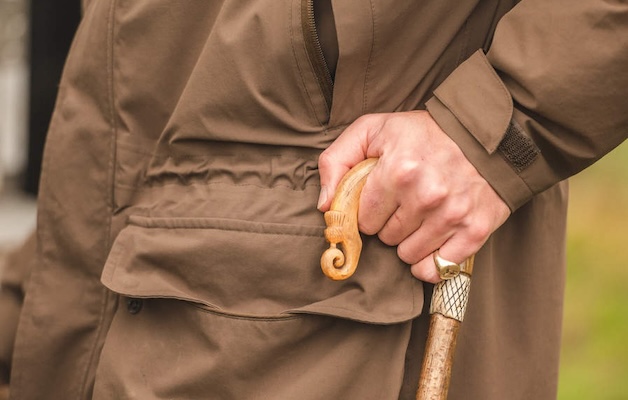Long worn by gentlemen as a signifier of status, the signet ring is making a curious comeback with a new cohort of champions leading the charge says Harry Wallop
When HM The King was crowned at Westminster Abbey, he had the Sovereign’s Ring placed on his right hand. It is a clunking bit of bling, the Union flag made out of diamonds, sapphires and rubies, and often called the ‘marriage ring of England’. He wore it just for a few hours before it was returned to the Tower of London. He did, however, arrive at the ceremony wearing another ring, one whose history and symbolism arguably is far greater: his signet ring, an item he has not taken off since the early 1970s.
The signet ring – what does it mean?

Few other items of fashion carry quite the same baggage as the small bit of gold worn by certain men – and some women – on the little finger of their left hand. Because a signet ring is not just a piece of jewellery. It is a signifier. “What you are doing when you are wearing a signet ring is that you are announcing to the world you are a gentleman,” says Paul Fox, the editor of The Coat of Arms, the quarterly published by the Heraldry Society. “Everyone who has a signet ring is declaring a status.”
In the old days that status was: my family has a coat of arms, and ideally an ancient one. People who wore signet rings were inescapably posh. I say this as a man who inherited his grandfather’s rather beautiful carnelian signet ring, which – excuse the bragging – I can date to the 1920s because above the family crest of a mermaid there is a viscount’s coronet; he had yet to inherit his earldom. But after wearing it as a young man, I stopped doing so in the late 1990s, about the same time as John Prescott declared, “We’re all middle class now.” I liked the ring, but I didn’t like the way it branded me as a toff in an increasingly meritocratic world in which I was trying to make my mark.

Male jewellery
In recent years, however, signet rings have undergone something of a curious revolution. Not only have sales jumped, but the purchasers are not exclusively those who might wince when someone brings an over-and-under to their shoot. “It’s no longer just public schoolboys or the aristocracy,” says Guy Burton, director of Hancocks, a jeweller that makes all Victoria Cross medals and specialises in signet rings, having made Edward VII’s signet ring when he was Prince of Wales. Burton says he is taken aback at how signet rings have come back into fashion. “It’s gone up a lot recently. We make about 40 a month. About five years ago it was just 10 a year. There’s a lot of new blood coming into the market.”
Partly, this is down to male jewellery no longer being seen as poor form. For my father, born immediately after the war, men wearing necklaces or rings, even wedding bands, were considered spivvy at best, criminal at worst. “Rationing and reduction of available material meant everyone cut back and, together with a need to man up and show the stiff upper lip, men’s jewellery did not suit the culture of the period,” explains Helen Molesworth, senior curator at the Victoria & Albert Museum and one of the world’s leading ring experts. “Signet rings, however, because they were designed as indications of heritage, rank and class continuity, were always the exception.”

James Blunt sporting his signet ring
For the Love Island generation, a bit of gold on a man is no longer considered vulgar or effete. My 17-year-old son thinks it is quite normal to wear a necklace. When it comes to signet rings specifically, social media has played a part. In 2020, Signet Ring Social was set up on Instagram by Charles Rolls, 26. A modern-day Sloane Ranger Handbook, it affectionately takes the mickey out of those who wear a signet ring alongside their Schöffel (‘the Chelsea life jacket’), Chameau wellies and embroidered velvet slippers (from Trickers, one hopes). It has quickly gained 36,000 followers and championed the small number of celebrities who now wear them, including James Blunt, the former Guards officer and singer (born James Blount), and Henry Cavill, who went to Stowe before he landed the role of Superman.

Henry Cavill and signet ring
Kieran Widdas, 16, has a signet ring. He attends a fee-paying school in London but describes himself as “definitely not an aristocrat” and says lots of his friends, from very normal families, have started to get them. “I think the promotion of signet rings on Instagram through accounts such as Signet Ring Social makes them more inclined to get them.” Even though the accounts are poking fun at the phenomenon? “Yes, they are satire, but they make you want to be in on the joke. They are not malicious.”
The unspoken rule of the signet ring
But though signet rings may have shaken off some of their cultural baggage, there are still an awful lot of unsaid rules about what one should – or should not – have engraved on them, and how one should wear them. Everyone agrees it should be your left hand (unless you are left-handed) and that it should be on the little finger. Why? “There’s no firm reason for this, it’s just tradition that’s accrued over many years,” says John Tunesi of Liongam, the secretary of the Heraldry Society.
Most people who have a family coat of arms choose to have just the crest – the wolf, stag, oak tree or whichever device that goes above the helm of the arms. If you don’t know what your crest is you need to consult Fairbairn’s Book of Crests. “There is no official book but Fairbairn’s is pretty much the Bible of crests,” explains Gary Mayoh at Rebus, a modern signet ring maker in London.

He shows me the three volumes of Fairbairn’s that most jewellers own. It is a beautiful encyclopaedia of heraldry. However, it also proves that a genuinely unique family crest is pretty rare. What I think of as the distinctive Wallop mermaid – with her left hand holding a comb by her side – according to Fairbairn’s can also be used for families with the following surnames: Bonham, Bruer, Brumherd, Byrne and 40 other families. It’s rather crushing.
Crests on a signet ring
Many jewellers, including Hancocks, have digitised Fairbairn’s, last updated in 1903. You can type your surname into their ‘crest finder’ and discover what you might be entitled to. One duke’s brother, who wears a signet ring, tells me: “A signet ring should only show the crest. The full coat of arms would definitely be a giveaway for a wrong ‘un.” I was always told that too. But some experts disagree. “I would suggest the arms are much better than the crest because the arms should be unique whereas the crest can be duplicated by other families,” argues Tunesi.
He might be right, but if you opt for your full coat of arms, it does mean you’re having to squeeze a lot of detail on to a pretty tiny piece of gold. And though Tunesi is adamant it is poor form to use another family’s crest (however fetching it might be) on your ring, he is very relaxed about women wearing them – an increasingly common trend, according to jewellers. “It’s not strictly right, because ladies do not bear crests, but I think we can turn a blind eye to that,” says Tunesi. “They are proud of their armorial heritage.”
If you don’t have a coat of arms, most people opt for their initials. Both HRH The (new) Duke of Edinburgh and his brother, The Duke of York, have just ‘E’ and ‘A’, respectively, on their signet rings, with coronets above. What you must never do is leave it completely blank, which some people do. “It’s awfully naff,” says Rolls of Signet Ring Social. “It’s usually some shiny-blue-suit-wearing type that you meet in the Lennox enclosure at Goodwood with a tattoo on their neck.”

It is also pointless, because a signet ring is the ultimate form of personal branding, one that stretches back not just centuries, but millennia. Molesworth at the V&A points out that the earliest signet rings date to the fourth millennium BC. From the very earliest days they were functional, acting both as decoration and a way to stamp your name in an era pre-writing. The Egyptians even had ones that allowed you to rotate the bezel – with a scarab on one side and the name of the owner on the underside. By Roman times they were exclusively for the elite – by law, only nobles could wear gold rings. “Caesar’s own seal was the image of Venus – perfectly in line with our hereditary signet seals today, as he claimed ancestry back to Venus. Then and now we have used signet rings to establish our own great and small dynastic order,” says Molesworth.
That association between the nobility and signet rings, and the nobility’s claim to ancient lineage, has never truly been broken, even as jewellery fashions have ebbed and flowed. After more than a couple of decades of not wearing my signet ring, I have started to again. Not just because I am old enough to no longer care if someone thinks I am silly and posh. But because I love the idea of wearing something that links me back to my family and the past.





